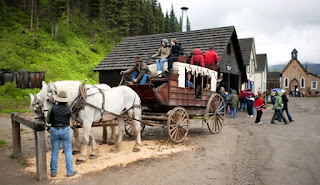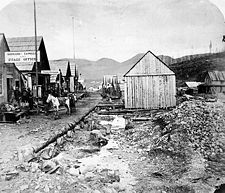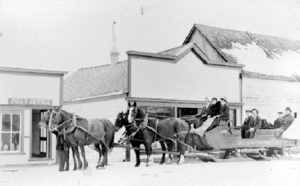There was a lot of poverty in Europe when the Gold Rushes started in California and the Cariboo and then the Yukon. Famines and political unrest sent folk off to emigrate on long and arduous journeys.  Most people were hoping for a better life and many were hoping to strike it rich so they came to British Columbia on sea routes. Some landed on the East Coast of North America and travelled across the continent down the St. Lawrence River and around the Great Lakes.
Most people were hoping for a better life and many were hoping to strike it rich so they came to British Columbia on sea routes. Some landed on the East Coast of North America and travelled across the continent down the St. Lawrence River and around the Great Lakes.
 Most people were hoping for a better life and many were hoping to strike it rich so they came to British Columbia on sea routes. Some landed on the East Coast of North America and travelled across the continent down the St. Lawrence River and around the Great Lakes.
Most people were hoping for a better life and many were hoping to strike it rich so they came to British Columbia on sea routes. Some landed on the East Coast of North America and travelled across the continent down the St. Lawrence River and around the Great Lakes.
Not many became rich but those intrepid travelers did open up this country and begin farms, ranches, mines, sawmills, stores, transport companies and small village businesses. They built the first schools and churches in each small community. 

We owe those pioneers a deep gratitude.  After coming around the Cape of South America they would stop off at San Francisco to board ships heading to Victoria on Vancouver Island,
After coming around the Cape of South America they would stop off at San Francisco to board ships heading to Victoria on Vancouver Island,  eager to take steamers up the Fraser River to Yale and then hike or take a stage up the trail to Barkerville. Above is an old picto-map of the route up river to Barkerville.
eager to take steamers up the Fraser River to Yale and then hike or take a stage up the trail to Barkerville. Above is an old picto-map of the route up river to Barkerville. Some went further up the coast to Bella Coola and trekked inland from there. We did that trip last Spring. We were glamping (glamorous camping) but even so ended up with a great respect for those first settlers. You had to be tough and clever to survive. Too many of them met swift ends due to disease or accidents.
Some went further up the coast to Bella Coola and trekked inland from there. We did that trip last Spring. We were glamping (glamorous camping) but even so ended up with a great respect for those first settlers. You had to be tough and clever to survive. Too many of them met swift ends due to disease or accidents.
 After coming around the Cape of South America they would stop off at San Francisco to board ships heading to Victoria on Vancouver Island,
After coming around the Cape of South America they would stop off at San Francisco to board ships heading to Victoria on Vancouver Island,  eager to take steamers up the Fraser River to Yale and then hike or take a stage up the trail to Barkerville. Above is an old picto-map of the route up river to Barkerville.
eager to take steamers up the Fraser River to Yale and then hike or take a stage up the trail to Barkerville. Above is an old picto-map of the route up river to Barkerville. Some went further up the coast to Bella Coola and trekked inland from there. We did that trip last Spring. We were glamping (glamorous camping) but even so ended up with a great respect for those first settlers. You had to be tough and clever to survive. Too many of them met swift ends due to disease or accidents.
Some went further up the coast to Bella Coola and trekked inland from there. We did that trip last Spring. We were glamping (glamorous camping) but even so ended up with a great respect for those first settlers. You had to be tough and clever to survive. Too many of them met swift ends due to disease or accidents.
Some came along the trail north on land from the United States to find the Fraser River at Yale (bottom right #14).
Above are the two most common routes taken.  Our ancestors took the eastern (green) route north shown below,
Our ancestors took the eastern (green) route north shown below,
 Our ancestors took the eastern (green) route north shown below,
Our ancestors took the eastern (green) route north shown below,
The First Nations folk must have puzzled over these strange intruders. All they wanted to do was dig up soft rocks that you couldn't eat.  Wild onions or carrots would make sense, but rocks????They were very willing to be helpful though, and did not cause the clashes that happened in the middle and western States as that country was opened up. (They did conduct their own internal and inter-tribal clashes and had slaves stolen from tribes as far away as the USA) They became excellent game guides, trail guides and cowboys on the ranches. Their skills were valued. The Scots and the French knew how to work well with them and that is where most of our Metis (may-tee) folk come from. They also knew a lot about ethno-botany and cures or medicines to aid many ills. But mostly they knew the best places to camp and the shortest routes to use. They also were great trappers, so the Hudson's Bay Company was willing to support their industries.
Wild onions or carrots would make sense, but rocks????They were very willing to be helpful though, and did not cause the clashes that happened in the middle and western States as that country was opened up. (They did conduct their own internal and inter-tribal clashes and had slaves stolen from tribes as far away as the USA) They became excellent game guides, trail guides and cowboys on the ranches. Their skills were valued. The Scots and the French knew how to work well with them and that is where most of our Metis (may-tee) folk come from. They also knew a lot about ethno-botany and cures or medicines to aid many ills. But mostly they knew the best places to camp and the shortest routes to use. They also were great trappers, so the Hudson's Bay Company was willing to support their industries.
 Wild onions or carrots would make sense, but rocks????They were very willing to be helpful though, and did not cause the clashes that happened in the middle and western States as that country was opened up. (They did conduct their own internal and inter-tribal clashes and had slaves stolen from tribes as far away as the USA) They became excellent game guides, trail guides and cowboys on the ranches. Their skills were valued. The Scots and the French knew how to work well with them and that is where most of our Metis (may-tee) folk come from. They also knew a lot about ethno-botany and cures or medicines to aid many ills. But mostly they knew the best places to camp and the shortest routes to use. They also were great trappers, so the Hudson's Bay Company was willing to support their industries.
Wild onions or carrots would make sense, but rocks????They were very willing to be helpful though, and did not cause the clashes that happened in the middle and western States as that country was opened up. (They did conduct their own internal and inter-tribal clashes and had slaves stolen from tribes as far away as the USA) They became excellent game guides, trail guides and cowboys on the ranches. Their skills were valued. The Scots and the French knew how to work well with them and that is where most of our Metis (may-tee) folk come from. They also knew a lot about ethno-botany and cures or medicines to aid many ills. But mostly they knew the best places to camp and the shortest routes to use. They also were great trappers, so the Hudson's Bay Company was willing to support their industries.
Gold panning in the rivers and streams of British Columbia can still be a profitable hobby.

 Their descendants are now our engineers and doctors and entrepreneurs, but they had to work extra hard and battle racism to succeed.
Their descendants are now our engineers and doctors and entrepreneurs, but they had to work extra hard and battle racism to succeed. 
This has been a delight, refreshing my knowledge of these times and searching for new pictures. I did not get around to mentioning the contributions of other immigrants like the Swedes and the Italians.
I have blathered on long enough. Good night, and don't let the bed bugs bite, as they did in the olden days.
















































